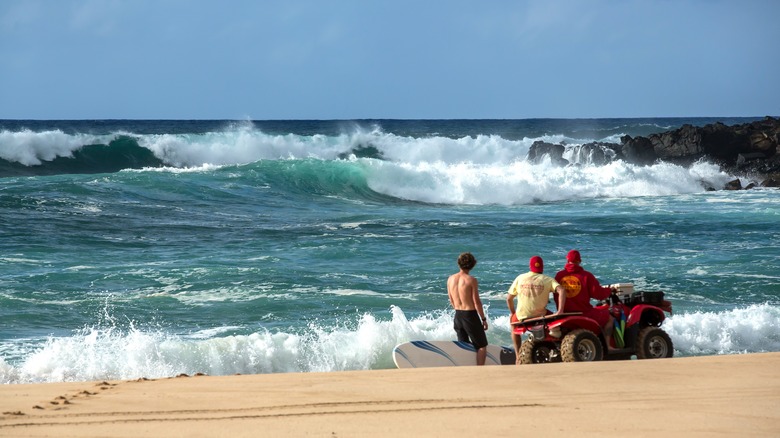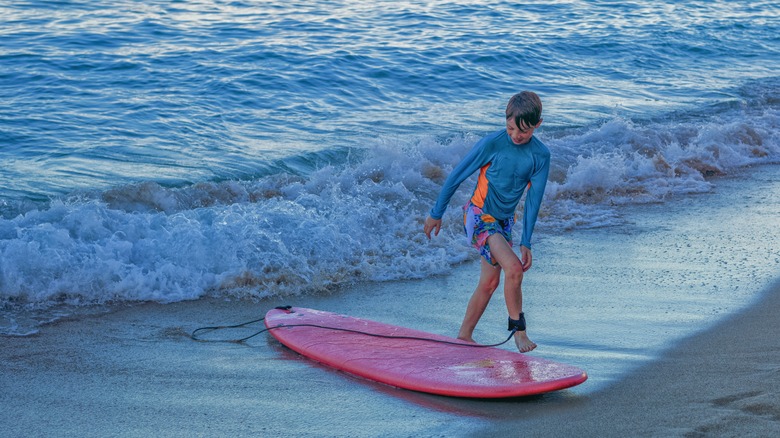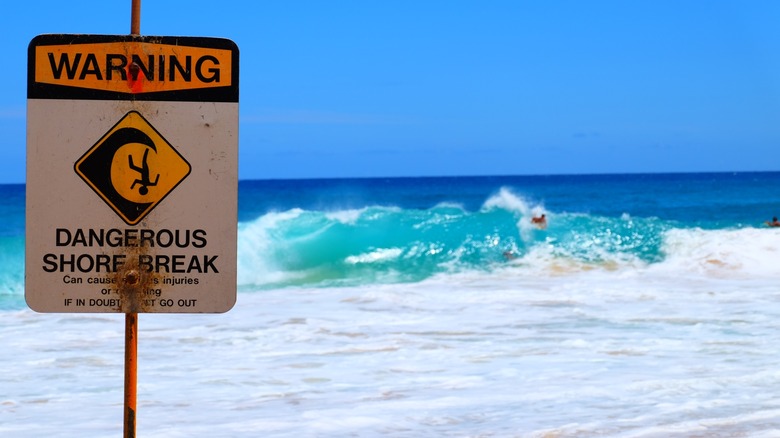Hawaii's Beaches Are Some Of The Most Dangerous In The World. Here's Why
Vacationers from the United States hardly need to fly to the middle of the Pacific Ocean to enjoy great beaches; it's not like the mainland is exactly short of a few beautiful stretches of sand on which to spend a well-earned break. However, Hawaii attracts more American visitors than from any other nation, to the extent that U.S. travelers outnumbered the local population by five to one in 2023. It's not hard to see why so many sun seekers go the extra few thousand miles. With its stunningly diverse landscape, welcoming culture, and spectacular beaches, the Aloha State is many people's idea of a tropical paradise. Yet the dreamy natural surroundings and friendly welcome shouldn't distract visitors from one alarming fact: Hawaiian beaches can be very dangerous for the unwary or unprepared.
Indeed, some stunning locations are too dangerous for swimming and the stats are no joke. Lifeguards on Oahu are called into action around 1,100 times every year (according to the Hawaii Lifeguard Association), and an average of 50 people drown annually across the entire island chain. That isn't considered drastically high when weighed up against the millions of people who swarm to the archipelago each year, but it is telling that half of all fatalities are visitors to Hawaii. Rip currents, powerful waves, and the absence of lifeguard coverage in some places are all contributory factors. A lack of local knowledge can also be fatal, especially when faced with more unpredictable ocean conditions than back on the mainland. Let's take a closer look.
Why are Hawaiian beaches dangerous?
Hawaii is one of the world's best places for surfing, but it is not for the faint-hearted: Waimea Bay is considered one of the deadliest surfing spots on Earth. One of the reasons for this lies just offshore. The 50th State is the most isolated population center on the planet, and unlike Florida or California, it doesn't have a continental shelf to absorb the power of the waves. Unlike the comparatively shallow waters off the mainland, it drops off quickly and plummets to a depth of up to 2,000 feet less than a mile from the coast.
That means you have big waves coming in from all directions carrying far more energy and, in some locations like Magic Sands, breaking directly on the beach. This can prove a menace to swimmers even in shallow water and may even catch out unwitting paddlers. This is why Hawaii accounts for the highest number of back or neck injuries sustained in the surf in America. Sandy Beach Park has become famous for breaking necks, earning it the unenviable nickname "Broke Neck Beach."
The types of waves encountered vary depending on the season, and the unpredictability factor presents another danger. These conditions often result in fearsome rip currents that can drag swimmers out to sea. To complicate matters, some areas have steady rip currents while others have more sporadic flows that last from a few minutes to many hours. What appears safe one moment could prove deadly the next.
How to stay safe and enjoy Hawaiian beaches
Hawaii has 130 beaches dotted along just 112 miles of coastline, but not all are supervised by lifeguards. It is strongly advised that you choose a beach with a lifeguard on duty if you plan to go in the water, but they're not just there to fish people out if they get in trouble. They can also provide valuable advice about ocean conditions before you take a dip.
Don't let yourself be lulled into a false sense of security by the presence of rescue services. Pay attention to warning signs on beaches, particularly the ones regarding rip currents. These deadly forces are the leading cause of surf rescues in the world, and It's also a good idea to recognize the signs before you enter the sea. They usually occur when strong water flows through a low point in a sandbar, creating a fast and powerful current that can be very dangerous. Look out for thin, muddy streaks in the water where waves aren't breaking — that is a good indication that a rip current may be present.
Other warning signs to heed are ones regarding dangerous shore breaks and high surf. Once again, the deep water surrounding Hawaii can mean a lot of water dumped right on shore, which can result in serious injuries or even death. But if you keep your wits about you and don't underestimate the forces of nature, you will have an unforgettable vacation in Hawaii.


